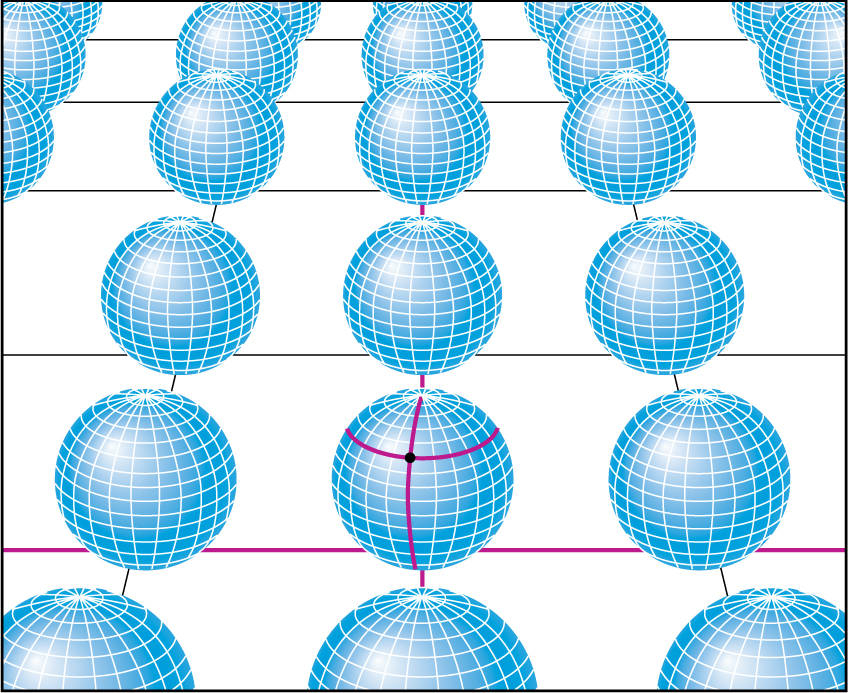26-7 String theory attempts to unify the fundamental forces and predicts that the universe may have 11 dimensions
While we have a growing understanding of the early universe, there remains a veil obscuring the first 10−43 seconds after the Big Bang. These very first moments in the history of the universe, whose duration was the Planck time, set the stage for what would come after. To understand this brief interval, we need to construct a quantum-mechanical theory that unifies gravity with the other fundamental forces of nature and that reconciles quantum mechanics with gravity—a theory of quantum gravity. While unification remains an unfinished task, remarkable progress has been made in recent years. One major development is that physicists have abandoned the idea that there are only three dimensions of space.
Beyond Four Dimensions
In his special and general theories of relativity, Einstein combined time with the three known dimensions of ordinary space, resulting in a four-dimensional combination called spacetime (see Section 21-1). In 1919, the Polish physicist Theodor Kaluza proposed the existence of a fifth dimension. Kaluza hoped to describe both gravity and electromagnetism in terms of the curvature of five-dimensional spacetime, just as Einstein had explained gravity by itself in terms of the curvature of four-dimensional spacetime (see Section 21-2).
In Kaluza’s theory, a particle always follows the straightest possible path in the four space dimensions he proposed. But in the three dimensions of ordinary space, the path appears curved. Hence, it appears to us that the particle has been deflected—by force—and this is Kaluza’s mechanism to describe gravitational and electromagnetic forces. Kaluza’s hypothetical fifth dimension exists at every point in ordinary space but is curled up so tightly, like a very tiny sphere, that it is not directly observable (Figure 26-24).

In 1926, the Swedish physicist Oskar Klein attempted to make Kaluza’s five-dimensional theory compatible with quantum mechanics. While he was not successful, Klein discovered that particles of different masses could be identified with different vibrations occurring in the tiny sphere of Kaluza’s fifth dimension.
String Theory and Speculative Models of the Universe
Subatomic particles may actually be multidimensional membranes
When Kaluza and Klein developed their theories, gravity and electromagnetism were the only known forces of nature. Today we know of four fundamental forces, which suggests that modern unification theories might require even more than five dimensions. Edward Witten at Princeton University has argued that a geometric theory for describing all four forces would work best with 11 dimensions, 10 of space and 1 of time. These models that attempt to unify all the forces of nature, including a quantum mechanical description of gravity, are called string theory. (There are also related names, such as superstring theory and M-theory.)
We see only the regular three dimensions of space, and one dimension of time. As with Kaluza’s theory, particles traveling straight in 11-dimensional space would appear to take curved paths in ordinary three-dimensional space. From our perspective, these curved paths would be the result of the four known forces acting on the particles.
Theoretical physicists have shown that if there are indeed 11 dimensions, there must also exist very massive particles that have not yet been discovered. The more massive the particle, the more energy is required in particle accelerators to create and observe it, and particle accelerators might not ever be able to reach these very high energies. Some of these speculative particles may be the dark matter that pervades the universe. Even more bizarre, the new theories no longer regard fundamental particles, such as electrons and quarks, as tiny points of mass. Instead, these particles may actually be multidimensional strings or membranes, wrapped so tightly around the extra dimensions of space that they appear to us as points. Just as a guitar can vibrate in different ways to make different sounds, vibrations of these fundamental strings correspond to different particles and the forces between them.
One criticism of string theory is that its predictions are too far beyond the energies that can foreseeably be tested. However, when the extremely large energies of the Big Bang are considered, proponents of string theory hope that the early universe itself will have acted as a powerful cosmic particle accelerator that left behind telling evidence. In this manner, astronomy might be used to gather evidence for strings whose vibrations lead to all the known forces in nature.
CONCEPT CHECK 26-12
If, as suggested by string theory, there really are 11 dimensions, why don’t we notice them? How many dimensions appear to be hidden?
We only notice four dimensions—three for space and one for time. That would leave seven hidden dimensions of space. If these dimensions are curled up tightly, as in Figure 26-24, we would not notice them until experiments could probe the tiny microscopic sizes scales in which they are curled.
We shall not cease from exploration
And the end of all our exploring
Will be to arrive where we started
And know the place for the first time.
T. S. Eliot, Four Quartets